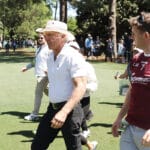Edoardo Molinari has always been a popular guy on Tour but a lot of people depend on him now, including every member of the victorious Ryder Cup team in Rome.
After forging a side business as a performance coach to Viktor Hovland and Matt Fitzpatrick, Edoardo Molinari went on to play a pivotal role as Luke Donald’s stats man and most trusted lieutenant as Europe won back the Ryder Cup in style in Rome.
When Donald replaced Henrik Stenson at the European helm following the Swede’s departure to LIV, one of the first calls he made was to Molinari to inform him that, like Stenson, he was fully intent on picking the Italian’s brain and would be delighted if Molinari would reprise the role he was undertaking for Stenson under the new, Donald regime.
The 42-year-old is still competing on the DP World Tour, yet the last year he was just as busy assisting Luke Donald for the Ryder Cup as he is earning ‘extra pocket money’ as one of golf’s leading statisticians. His to-do list never seems to get any smaller. Once finished on the course and in the gym, he’ll spend the evening sifting through more numbers than you’ve got in your phone book. He’ll go through every shot he hit during his round, noting his tendencies and the success of others, which will then shape his on-course strategy in the following days. He’ll do the same for the Hojgaard twins, Jordan Smith, and anyone else who may require his help or expertise this week.
He has a close interest in around 25 players at any given time, though that number does not include a shortlist of would-be Ryder Cup stars given to him by Donald. With just a few clicks of a button, he can tell you which players are best suited for foursomes, which strategy works best on the driveable par 4s at Marco Simone, and why Viktor Hovland’s short game is far better than many will have you believe.
Molinari has everything to hand on his own data platform, StatisticGolf, which he built during lockdown while everyone else was hitting golf balls into bed sheets suspended on washing lines. With the help of two full-time staff members, the Italian invites users to input as much data as they want in return for a personalised profile of their game.
The goal, he says, is to provide players with actionable insights and trends which go far beyond telling them how many putts they hit yesterday. Instead, it might reveal that they tend to miss a greater proportion of left-to-righters, or that they struggle more on Bermuda greens compared to bent grass.
Matt Fitzpatrick was the first to buy into Molinari’s data-driven approach in 2019, and credited it with helping to inform his practice, schedule and strategy in the build-up to his US Open victory last year. This month Molinari provided the same service to all 12 members of the European Ryder Cup team. He bristles at the suggestion that he might’ve been Europe’s most trusted lieutenant, but he was almost certainly Europe’s secret weapon in their quest to win back the Ryder Cup.
In the aftermath of Europe’s 16.5-11.5 victory, Donald, along with praising his entire vice-captain panel, singled out Molinari for special praise. “Well, of course, Dodo’s extremely important,” Donald said. “I think the game of golf has really become dominated with statistics, but you know, all my vice captains were immense and literally got so much from Thomas [Bjorn], our past captain. He’s been there before, winning captain.
“José María {Olazábal] was extremely inspirational. He doesn’t speak much, José, but when he does, we all listen. There’s a deathly silence in the room in our team room when he speaks, and it was amazing. Nicolas Colsaerts, he has the biggest heart I know, and this Ryder Cup means so much to him. Francesco, as well. Every single one of them meant so much to me and were a big help.
“But obviously Dodo, I probably spent a little bit more time just because of the statistics, because of trying to figure out ways to tell all my guys why they were going to win; give them the confidence that when they stepped on that tee on Friday that they expected to win, and these are the reasons, and this is why you play and this is why we are going to be successful by the end of this week. Obviously Dodo is a big part of that.”
Before the Ryder Cup in Rome, we sat down with the Italian to find out more about his burgeoning side business, the role he played in Matt Fitzpatrick’s US Open win, and what the stats really say about possible Ryder Cup pairings and picks.
This year your official role is listed as vice captain. But you’re so much more than that, right?
I would say I spend a lot of time chatting with Luke. The last few weeks we’ve started talking about possible pairings. The first few parts of my vice captaincy were trying to get the course set-up right, so it hides our team weaknesses and exploits our strengths. And we’ve done a very good job with that. Now we’re looking at possible picks and which players are a better fit for the course and the foursomes and fourballs. I mean, we’re not only doing the pairings based on stats, but it’s certainly one of the pieces of the puzzle.
Most tour pros go into course design or coaching once they reach a certain age. Why statistical analytics?
Because I’ve always enjoyed doing it for myself. I have an engineering degree but even before that I was collecting my own stats in a very simple way. A few years ago, Matt Fitzpatrick came to me asking if I could help him. That’s how it all started. I then had to change what I was doing because it was all done in Italian. I wanted to make it as easy as possible for him and for other players. He spoke very highly of me in interviews and then more players followed. That was the big thing.
So it became a lockdown project for you?
Yeah, because during lockdown I had nothing to do. Pretty early on I reached out to (my putting coach) Phil Kenyon and I said, “I’ve got this in mind, would any of your players be interested?” He reached out to a few and a couple of days later I had a good chat with Fitzy. I showed him what I had in mind and he said, “If you do this, I would not only like to subscribe, but I’d like to be an investor.” I was like, “I’m not sure about that part, but you could definitely be my first client.”
When I saw how keen he was, I thought, if I can make this right, he might not be the only player using it. Initially I thought I might manage 10 players at the most within two years, but I got to 10 players within two and a half months. I had to hire
two people working full time because I just couldn’t do it all by myself. I can’t spend six hours a day writing code now.
How in-depth do you go?
In the beginning, it was very simple. It was just fairways and greens hit, where my misses were, the distance of my putts, the breaks on the putts. And then in time I started adding more and more layers. We now factor in wind direction, where the pin is on the green, your intended target or shot shape. You name it, you can enter whatever you want.
For putting, you have all the breaks, the slopes, the distances, whether you missed the putt because you underread it, overread it, or because of too much speed. We’re starting to get some data from IMG and ShotLink to give players percentages of up and downs to various pins. All of a sudden you can build a plan so you know which pin positions you can take on and where the best places are to miss.
Off the tee, we can tell them whether it’s better to hit driver, 3-wood or to lay-up, based on historical data for how the hole has played and your own strengths and weaknesses. You can then optimise your strategy on certain holes.
Is everything detailed in a report?
No, at the moment they get all the information via WhatsApp. We give them different reports with different levels of information. We have a tournament report and a stretch report, so if a player plays two or three events in a row, it goes a bit more in depth about their patterns of play. We also produce a quarterly report, where we analyse their game over the last three months and identify what they need to work on ahead of tournaments coming up. Then, at the end of the season, we sit down with the whole team and offer advice on scheduling and what they need to improve during the off season.
Stat tracking has only really come to the fore in the last few years. How quickly did you see the benefits in your game?
I saw it pretty quickly to be honest. I thought, if I can understand my game a little bit better and find out where I’m gaining shots and losing shots, I could practise more efficiently. Because I was in college, I didn’t have all the time in the world to practise everything. I had to have a plan when I went to the golf course.
I realised pretty soon that it’s almost impossible as a player to understand exactly where you’re losing shots, where you’re gaining shots and what you’re doing well and not so well. I’ve seen this with a number of players. Sometimes they change a driver because they think the new one is better. But then when you crunch the numbers, you see that the old one was gaining you 0.3 shots more per round. That might not sound like a much, but that could be the difference between a top 50 player in the world and someone just keeping their card.
How many players have bought into what you’re doing now?
Viktor Hovland has been using StatisticGolf for the last couple of years. Matt Fitzpatrick obviously, and there’s a few who don’t want to be named. I’ve got seven players inside the top 50 and another six or seven inside the top 100. It’s very humbling how every week someone is reaching out from the European Tour and PGA Tour, interested in what I’m doing.
Can you claim an assist then for Matt Fitzpatrick’s victory at the US Open?
I don’t want to make big claims, but I’ve spent a lot of time with Fitzy since joining his team. I remember early on when I started working for him, he was struggling with back-left pins. He went away, spent a lot of time on the range, and a few weeks later he finished third at Memorial. The pin was back-left on 18 and on 16. I had a message from him saying, “You’re a genius, I birdied 18.”
Going back to the US Open, a couple of months ago I went through some numbers to see how much players have improved after 12 months of working with me. Across 25 or so players, it worked out as a shot per week. Again, that doesn’t sound like a lot but when someone wins the US Open by one, it can be huge. I like to think I am helping a little bit.
For the last three Ryder Cups, each European captain has used the Twenty First Group’s 15th Club for their statistical analysis and data crunching.
Have you replaced them?
Yeah, that’s part of my vice captaincy role. It’s my job to provide all the data for before, during and after the matches. I will be doing it, but I’ll have my team as well to help with that. We did a trial at the Hero Cup in Abu Dhabi for both teams and I felt like it went down really well.
Luke Donald told us that you were key to the decision to opt for six captain’s picks. Why did you push so hard for it?
There’s a number of reasons. The more picks you have, the more flexibility you have in choosing the players you need. If you have fewer picks and more automatic spots, you might find yourself with a player who played very well in the beginning of the qualifying period and then played very poorly in the last three months. This way it will make sure that the team will be on top form.
How many players are you tracking right now?
It’s an automated system so every week we get all the numbers on everyone. I’d say we’re looking at 20 to 25 players.
Who has impressed you most before the picks were made?
I’m not going to give names. There were probably seven or eight guys that were pretty much guaranteed to make the team. I think the last with about four spots wide open.
Was Aberg a player who was quite hard to track because you didnt have much data on him as an amateur?
No, we did cover his amateur career, funnily enough. We have data on him. I requested to play with him for the first two days in Dubai because I was seeing his results as an amateur and thought he must be special. I was extremely impressed.
Off the tee, he was as good as anyone I’ve ever seen anywhere. He’s still very young and has only just turned pro, so it’s going to be extremely difficult for him to be in the team, but you never know. I wouldn’t put anything beyond Ludvig’s abilities. He’s a fantastic player.
On paper the Americans look like the big favourites to retain the Ryder Cup. What do the stats say?
I will say it’s going to be much closer than most people think. When they came to Paris, on paper they were the best team America had ever had up until that point, and they got beat pretty hard. A lot of players from our side are also coming into form. Look at Tommy Fleetwood. Every week he seems to finish in the top five on the PGA Tour. I would say, looking at the big picture of our team, it’s looking very good.
The above feature appeared in the 2023-7 edition or Irish Golfer. To view the fill edition click below
























Leave a comment